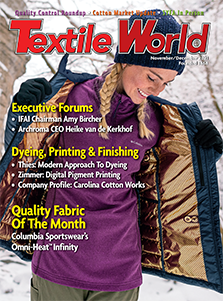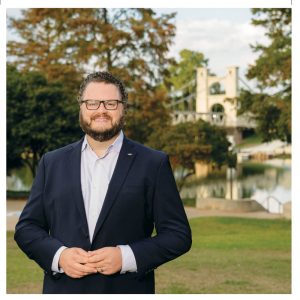
Ascend Performance Materials’ Harrie Schoots shares his thoughts on AATCC, its 100thanniversary and vision of AATCC’s future as he begins his term as AATCC president.
By Rachael S. Davis, Executive Editor
The Research Triangle Park, N.C.-based American Association of Textile Chemists and Colorists (AATCC) was founded in November 1921 by a small group of U.S.-based dye manufacturers at a meeting held at the Engineer’s Club in Boston. Louis A. Olney, a professor at the Lowell Textile School and editor of the Technical Section of the American Dyestuff Reporter, is considered to be AATCC’s founder.
According to AATCC: “The need for American textile test methods became apparent during the First World War, when the blockade in the Atlantic prevented European dyes from coming to America, and the fledgling American dye manufacturers struggled with providing consistent products.” This realization led AATCC to form its first subcommittee in 1922, to study the colorfastness of printed and dyed cottons, formulate testing procedures, and develop standards for fastness.
This original, small, U.S.-based group has become a global association that will celebrate its 100th anniversary in 2021. Test methods remain a large part of AATCC’s focus. Committees, comprised of AATCC members, are responsible for developing and maintaining the test methods, and the association offers test method training and courses for interested parties. The association also offers networking opportunities through meetings and conferences.
Harrie Schoots recently received his Presidential AATCC lapel pin, which marks the beginning of his term. Schoots, senior business development leader at Houston-based Ascend Performance Materials, has long been involved with AATCC during his career, most recently as president elect.
According to AATCC, the president: “is an active, long-term senior member of the Association. S/he has a general knowledge and understanding of the mission and history of the Association, acquired from prior service on numerous administrative, publications or technical committees within his/her respective local section(s) and at the national level. This individual has also held office at the section or interest group levels.”
Schoots will serve as AATCC president for the next two years, presiding over meetings of the board of directors and the awards banquet at the international conference; attending sectional and interest group meetings, as well as symposia and association programs; promoting the mission and goals of the organization, as well as mentoring and assisting the next generation of textile students, among other duties.
He replaces Kerry King who moved into the role of immediate past president, a title she will hold for the next two years.
188BET金博宝下载recently had the chance to speak with Schoots to learn more about AATCC and his goals for the organization during his tenure, among other topics.
TW: What led you to the textile industry?
Harrie Schoots: I graduated in 1996 from NC State with a B.S. in textile chemistry with a concentration in dyeing and finishing. I transferred from a school in Boston to NC State when my father went to work at the university.
He was in nonwovens his whole life and is one of the inventors of the blue and white reusable Handi Wipes®. I’m a first-generation American. My family emigrated from Holland, and as a Dutch-American, one way to really rebel, was to not do my homework and not do what my father did. Seeing how things turned out, I guess I’m not much of a rebel after all.
Anyway, chemical engineering at NC State is a big deal and I didn’t know that. I didn’t have the grades and was rejected from the program. When I met with my dad at his office on the new centennial campus at NC State, he said “go down the hall and there is a guy there that will talk to you about textile chemistry.” I got the sales pitch of my life from Tim Clapp. I thought it sounded great and couldn’t believe you could study that sort of thing in college. I transferred into the college of textiles and loved it. My GPA increased because I was so interested in the subject matter and I took two years of back-to-back textile chemistry courses. I believe I came out of school ready to go!
TW: When did you first become aware of AATCC?
Schoots: I learned of AATCC while at NC State. I thought the meeting I attended was just to have pizza. I did not know what AATCC meant when I was a student. The name is long and out of the five words in the name, only one of them is actually true — it’s an association. It’s not justfor textiles, it’s not just for chemists and it’s not just for colorists. And it’s definitely not just American. It’s an international association!
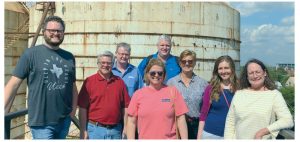
TW:如何标准化考试是有帮助的in your work?
Schoots: Unless you can prove something, nobody is going to believe you. AATCC test methods are an absolutely essential thing needed to sell products. It’s the only way to prove that what you say is actually true, and that means the consumer will recognize it.
Without standardized testing, you have only wear testing, which is inconvenient and difficult to quantify. Test methods are not just helpful, they are essential. They are the reason people can sell stuff. Us textile nerds never get credit for any of that, but we all know nothing gets sold unless our tests are taken seriously.
TW: The year 2021 is AATCC’s 100th anniversary? What do you see for your term as president, and does the anniversary impact your role?
Schoots: I didn’t realize I was going to be the 100th anniversary president. When I did the math and realized the timing, I thought, oh, that’s neat. But then I had that I’m
not worthy moment!
我以前见过这个职位的人我一个d seen the wonderful job that they have done. I’d also like to honor Kerry King as our most recent past president. She helped bring us into the COVID era very well — seamlessly in my opinion. I truly hope I can do the position honor.
There are three things I told Diana Wyman [AATCC’s executive vice president], whom I look forward to working with, that I’d like to focus on.
一个是我想要的在线状态stronger. We need to not ignore pandemic-related shutdowns, and let’s say it’s two years where we are all doing this stay at home thing. We need to upgrade our online presence, how we advertise meetings and when we have meetings. We also don’t have to hold virtual meetings at 7 p.m.
The second thing I told Diana, is I want more interaction with other textile and color organizations when it’s appropriate and when it’s synergistic. When you add in people meeting online today, we have less and less of an excuse not to interact. We need to work with kindred groups and non-profits in our industry that are too valuable to ignore. Why should we not meet with the fabric people if we are yarn people. Do we ignore cotton growers? Why are the buyers not involved with the fabric people? I don’t believe these entities are competitors, but rather full of synergistic opportunity.
The third goal is to make engagement with the student sections a little bit more enjoyable especially in the online meetings.
I’d like to have an online meeting with every student chapter during my time as president.
TW你能透露任何相关的100一个计划niversary?
Schoots: I would say the most important note is that we still hope to have our international conference next year, but we are probably going to delay it — and that’s a scoop by the way. We’re going to delay to maybe November, and if we do that, we believe it’s possible to have the conference next year. We’ll also host the event in a place where AATCC members who work in corporate jobs won’t have to travel so far to attend, so probably in the Raleigh/Durham area.
TW: What do you think is the true value of AATCC membership?
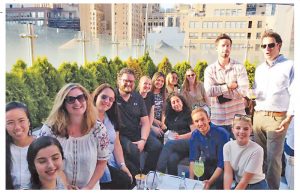
Schoots: Part of my answer to what I think AATCC’s value is, is this — If you read the book “Dyeing for a Living: A History of the American Association of Textile Chemists and Colorists,” you’ll notice there are two different viewpoints within AATCC going all the way back to the 1920s. One is that it is a technical organization meant to do technical work, fundamental research and development, this type of thing, which leads to the test methods. That purpose of course continues today, and AATCC is focused on managing test methods and growing new methods, as well as correcting and improving old ones. But the other side, is that AATCC is a networking group. It is an organization that is relatively rare in that it allows anyone from a student to an entry-level textile individual to a leader or owner of a company to gather in the same place at relatively low cost to no cost. There was a battle within AATCC for decades between these two groups — the people who wanted to network and share products to develop new business, and the people who were looking to engage in that fundamental research that needed to be done. Of course, both facets are important, but my work and focus has been to help other people connect with this network.
TW: What is the benefit of AATCC membership for students?
Schoots: Getting a degree in textiles means learning a trade. You’re not just getting a degree, you are gaining skills and people pay for those skills. Every time I talk to a group of students, I offer to take their call, schedule a meeting, get to know them a little, and then help them write their resume. The reason I can offer that — even though I’m busy — is because only 2 percent of students ever take me up on that offer. So, spread out over time, it’s doable. That one-on-one time, this mentorship, that’s what AATCC, I believe, is about for students.
When I graduated, I personally had more than 40 interviews on campus with dyehouses. They came to me. Now, these kids at NC State are scouring the boards looking for jobs.
Do they have any companies come to campus for interviews? I’m not sure, but if there are any, it’s not 40 companies.
The students are shy. You really do have to reach out, and I’m going to continue to work on that. How can we be useful to the next generation? How can we help them learn the things the industry wants? It’s not always just about jobs.
I helped to start a student chapter of AATCC at the University of Texas (UT) at Austin in May 2017. This a school that requires you are in the top 10 percent of your high school class to get in and most students are interested in medicine, engineering and business. These kids at UT Austin in the textile program at some point had to tell their families, I’m going there to learn how to make better textile products. These kids did not grow up with family members working in the industry. They have chosen to do this, and they have passion for it.
The first class, founding class, graduated last year. They held meetings, hosted speakers and learned how to use the things AATCC can offer them. I was just so proud of them. And at graduation, the students chose to make a cord to wear that identified them as AATCC student chapter members in good standing. The thing they wanted to wear at graduation, was this AATCC cord. If you can create that sense of pride just spending time once or twice a semester talking to the students, that’s what AATCC means to me. It’s a place you can impact someone’s entire career just by talking to them.
I also started hosting socials in New York City during the summers because I learned that many students spend summers there working for brands. We held one, then a second, then COVID killed the social we had planned this summer. We look forward to hosting a third sometime in the future!
Ascend fully supports this work. Without them and their support, I wouldn’t be able to do this. It’s me paying it forward.
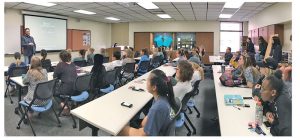
TW: What do you see for AATCC in the future, beyond your tenure as president?
Schoots: We’re going to learn it’s not a male-dominated business anymore. The industry is going to have to learn to understand the new demographics. This industry in particular also was heavily focused in the southeast, but that’s changing. We have active sections on the west coast. AATCC has a very active California section and we’re going to be led by the brands’ participation in my opinion. I believe the brands, retailers and apparel dealers and wholesalers will become more involved in AATCC in the future because of the answer to an earlier question — are tests helpful? They’re required, and people are going to be selling functionality more and more and more. And so AATCC will become more and more a place to share products, but also a place to measure them and explain their value. Because there aren’t as many production facilities outside of the southeast, it’s only natural that the brands are going to come to AATCC for help. I think the brands also should come to the international conference and committee meetings because they can get help that way.
Also, the people who will be retiring … see, I’m the youngest of the old people. Before I retire, all the people coming up behind me need to get this information out of my head and my colleagues’ heads. I believe that mentorship will play a big role in sharing that information and educating. There are not a lot of people running mills anymore, but everyone still needs clothes so I guarantee the industry is going to be here!
So, demographics are changing, functionality is getting to be more and more part of the sale, and this is the other piece — I think AATCC will be seen as more of an international entity. It should be noted that these test methods are international test methods. You’ll see the new technical manual will have a slight change in its name next year to state that it isinternational.
TW: In an earlier answer, you mentioned Kerry King and AATCC’s COVID response. Howdid Ascend respond to the pandemic?
Schoots: I was hired by Ascend to find new applications in textiles, and after creating Endur by Ascend™(See “Static Free? — Ascend’s Nylon 6,6 Answer Is ENDUR,”TW, May/June 2019), we were challenged to make a no odor nylon 6,6 yarn that is dyeable and not silver-based. There were some challenges spinning yarns using metals, but Ascend did develop this resin and it’s called Acteev™.
In February, shutdowns began and Ascend decided to test Acteev for viral protection. Tests showed a 99.9-percent reduction of SARS-CoV-2, the virus that causes COVID-19. This led Ascend to create a business division called Acteev. It was interesting how the project morphed from a more narrow “no odor” solution to an antiviral technology with its own division.
AATCC has a committee called AR31 and that’s going to be important over the next couple of years for me. Everyone needs to be educated on how to supply antimicrobials, how to talk about them, how to buy them. I look forward to helping in any way that I can to produce that education because I’m so closely involved with Acteev. We’ll have to see how things go with the Environmental Protection Agency (EPA) and the Food and Drug Administration. The EPA sees an antiviral callout as a public health message.
A company cannot claim a public health message unless the EPA approves it, and full registration takes two years. Ascend is currently involved in that process now.
November/December 2020

